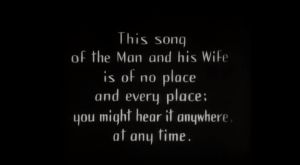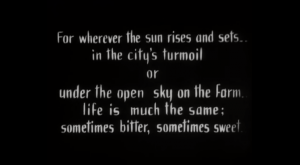Below is a close analysis of a certain shot in the film Sunrise: A Song of Two Humans. The shot is from 35:41-35:58. The film is below.
https://www.youtube.com/watch?v=GnLVMREVA6M
Sunrise: A Song Of Two Humans portrays the dramatic, comedic and horrorifing story of the human condition. Through topics like lust, love, grief and horror, this film inventively utilises the idea of film as an artform. The film, directed by F.W Murnau, was made using a popular film movement of the 1920s, German Expressionism. Sunrise, a silent movie, had a pinnacle of visual expressiveness, which without talking could still portray its meaning. Silent film is where the belief that cinema could speak an international tongue was understood. This was achieved through the several shots in Sunrise. Full of cinematic innovations, the cinematography featured particularly remarkable tracking shots. Also notable is that titles appear sparingly, with long sequences of pure action. Mise-en-scene and camera techniques are important factors which give meaning to a shot. Specifically, the famous tracking shot of the two main characters, the man and the woman, rushing across a busy road as she is running from him in fear. In this shot, the actors end up holding in an embrace, and they cross the road together, narrowly escaping the chaos of the city surrounding them.
This shot is immensely crucial in regard to the development of the story. The camera is shot as a long-focal-length lens with movement, and is weaving through people and cars following the patterns of the main characters. This tracking or dolly shot follows a chaotic direction, which complements Murnau’s discussion in 1928 that shots should “whirl and peep and move from place to place”. Mobile framing in Sunrise allows the angle, direction, distance, and level of a shot to change via a tracking or dolly shot. This is evident in the shot as the camera travels in several directions. In 1928, Murnau wrote “to me the camera represents the eye of a person, through whose mind one is watching the events on the screen. It must follow characters at times into difficult places”, which explains his reasoning towards this shot. This is evident, as the camera follows the strain on the relationship after trust has been broken. The story then follows the repairing of the relationship, but the struggle is shown in this busy shot.
This tracking shot appears a realistic situation as the camera mimics what is occurring in front of it. This shot was done in such a way to show the turmoil of city life, and how it can engulf a person. This is a strategic idea by Murnau, as the city is overwhelmingly dominant and influential in this shot, much like the city woman was to the mans thoughts on drowning his wife as a proposition for an escape. However, Murnau has filmed this shot in such a way in which the audience’s eyes are rarely, if ever, taken off of the characters. As the camera follows their movements, the shot is conveying that amid the craziness of outside factors, such as the city, or a city woman, the main focus will always come back to the love between a man and his wife. This conveys meaning as it implies the loyalty is still substantial within the man as he holds the woman across the street, providing the audience with the understanding that their relationship is important and worthy of repair.
Of all film techniques, mise-en-scene accentuates most accurately, the meaning and context of a shot. Filmmakers can use mise-en-scene to achieve realism, giving settings an authentic look or letting actors perform as naturally as possible. Essentially, mise-en-scene offers the filmmaker four general areas if choice and control regarding setting, costumes, makeup, lighting and staging. The setting of this shot is a stylised setting of the 1920s, with interplay of the city and the characters on screen. This shot visually includes traffic of vehicles and pedestrians colliding. The audience is shown this as the setting displays the overwhelmingly hectic and eventful life of city dwellers and thus brings up a juxtaposition between the lives of the man, wife, and the of city-goers, such as the city woman who attempts convinces the man to drown his wife. Due to the setting, the audience is continually reminded of the effect the city woman has had on the couple. We are shown the place where the man wished to live with the city woman, which has brought strong heartbreak to the wife. As the camera follows the couple, it is weaving between 1920s cars, and people, creating erratic movements. This emphasizes the immense busyness of the city, further conveying the influence the chaos of the city has had on the husband and wife.
The setting of this shot also makes the wife look very small comparative to her surroundings. She seems automatically out of place in the setting she is put in. This causes unease in the audience, knowing she is unsafe in a city, which has been the location and a reason for her fear and potential death. The audience sees her as small in size, as she is a victim. She was disregarded by her husband, and wanted dead. Therefore she is in danger on the roads, nearly being hit by several passing cars. This is shown to the audience as it reiterates the danger this woman is in when she is surrounded by such madness. This conveys that she is unsafe, which may foreshadow that something bad may happen to her later in the film. It is not until her husband tightly grips her and carries her to the other side of the road to her safety. This is ironic as this is located where he wants to be without her. However, this begins the development in the story of the realisation he has that he wants to be with her, and that his plot to drown her was a fault. Thus develops, a story about recuperating love.
Costume is coordinated with setting, and is an important factor in portraying the meaning and story of a film. The costumes depicted in the shot in Murnau’s 1927 film Sunrise are an accurate representation of the 1920s. Men featured are wearing suits, and most are wearing hats. This provides insight that they may be businessmen rushing to work in the active city. The husband wears a suit and large jacket. This formal attire is a slight juxtaposition to a more unperturbed outfit when he is at his home. After all, he did intend to visit the city, only without his wife. The woman, whom seems to be one of few women in the city, is wearing a hat and large jacket. Little skin is shown, which further portrays, to the audience, that she is a victim, as she is dressing like a respectable wife of that era.
Lighting in this shot seems to be quite natural. The lighting from this scene is from a strong sun, or an artificial light portrayed as a sun. This use of backlighting creates silhouettes in every person and car in the shot, elongating their profiles on the ground. These shadows cluster the city more, and give the people in the shot more substance. There is also use of low-key lighting, which creates contrasts, and sharper, darker shadows. Low-key lighting was applied to sombre, threatening, or mysterious scenes in this time. This makes the city look a much more hectic environment. The harsh ray of the sun accentuates the harsh city in which this shot is set. This stresses that the woman is suffering. The harsh lighting begins to fade as smoke from several cars covers the camera screen. This happens only after the husband and wife have embraced each other, which foreshadows that the merciless situation may tranquil and calm.
In creating mise-en-scene, the filmmaker stages an event to be filmed. In the city road shot in Sunrise, the comparative difference between the darkest and lightest areas of the frame guide the viewers’ eye to important parts of the frame, which are the couple. This is done to reiterate their relationship and struggles. The shot gives an emotionally expressive quality, which is sombre and anxious. Due to being a black and white film, this contrast gathered more light and hence this scene was suited to actual conditions, such as the ray from the sun.
The shot of the woman and man running across a busy road in an American city in Sunrise significantly contributes to the film. This shot connects the story as the audience is shown the setting and home of the city woman, who influenced the man to attempt to drown his wife. This shot showcases the chaos of the city life, and how it has overwhelmingly changed their relationship, as it is a dominant part of the shot. This shot also offers foreshadowing regarding the man and woman finding love again as he protects her from the world around her. This shot in Sunrise is a meaningful part of a movie, which tells a story of lust, betrayal, fear, love and grief through several film techniques.

